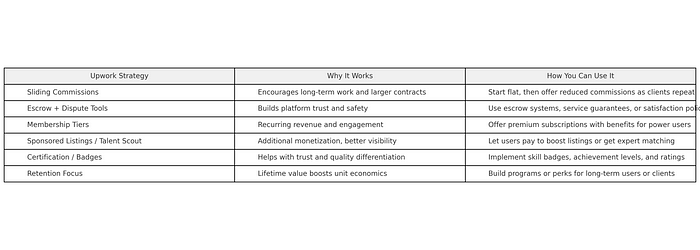Behind the Scenes of Upwork: How the World’s Biggest Freelance Platform Actually Makes Money
Upwork is a success story: over 5 million clients, tens of thousands of active projects daily, and more freelancers than some small countries have citizens. But beneath its popularity lies a finely tuned business model — designed to balance freelancer incentives, client experience, and platform growth.
If you build your freelance marketplace today, here’s why Upwork works, what you can learn from it, and how to apply similar principles to your own platform.
1. The Simple But Smart Commission Model
At its core, Upwork charges a service fee on each transaction:
- 20% for the first $500 billed between a client and freelancer
- 10% from $500.01 to $10,000
- 5% for billings over $10,000
This sliding scale model incentivizes long-term relationships. The more a freelancer earns from the same client, the more Upwork earns too. Yet freelancers pay less as earnings grow — encouraging loyalty to the platform.
2. Membership Plans: VIP Access for Both Sides
Beyond commissions, Upwork offers membership tiers:
For Freelancers (Connect Packages + Plus Subscription):
- Connects are tokens to submit proposals. Freelancers either buy them or earn a few monthly.
- Plus subscription ($14.99/month) offers benefits like unlimited connects, visibility stats, and ability to keep earnings private.
For Clients (Enterprise Tier):
- Clients can subscribe to an Enterprise plan with premium services like SSO, dedicated support, talent sourcing, compliance, and billing features.
These fee-based memberships make the platform more than just a transactional marketplace — they incentivize deeper engagement.
3. Project Types: Hourly vs Fixed-Price Revenue Strategies
Upwork gives clients two main engagement types:
🔹 Hourly Projects
Freelancers track time via Upwork’s desktop app. The platform charges based on hours logged — including a surcharge that helps fund the dispute-management process.
🔹 Fixed-Price Projects
Clients deposit funds into escrow — building trust — and withdraw them only after milestones are met. Upwork takes its commission when the freelancer is paid.
Both options ensure Upwork earns on every gig, regardless of format.
4. Protecting Trust with Escrow and Dispute Tools
In peer-to-peer marketplaces, trust is currency.
- Escrow holds funds securely until both parties agree.
- Dedicated teams help resolve disputes and enforce policies.
- Rating systems, achievements, and skill tests build reputation over time.
Freelancers and clients openly trade these safety nets — and pay for the privilege.
5. Buyer and Seller Playbooks: Creating Network Effects
Upwork thrives on network effects with some clever mechanics:
For Clients:
- High-intent clients often purchase “Featured” or “Talent Scout” packages for recruiter support.
- Enterprise clients pay for premium service.
For Freelancers:
- Top-rated badges, skill certifications, and job success scores help visibility.
- “Rising Talent” and “Top Rated” programs encourage quality over quantity.
These features encourage both sides to invest time and money in the Upwork ecosystem.
6. Add-On Services That Boost Revenue
Upwork’s core isn’t the only money-maker. They’ve added “extras” that make money — even when you’re not working on a project:
- Sponsor Job Posts: for priority placement
- Talent Scout: Upwork recruiters find the best talent for you
- Payment Protection: offers client and freelancer security on hourly and fixed jobs
- Enterprise services: compliance, consolidated billing, fraud protection
These are subtle upsells that enhance the user experience and generate extra revenue.
7. Focus on Retention and Customer Lifetime Value (CLV)
Upwork doesn’t just aim for transactions; they build lifetime relationships.
- Sliding commissions reward ongoing projects
- Memberships provide freelancers and clients recurring engagement
- Talent programs (Top Rated, Enterprise) promote platform loyalty
- Skill badges and certification tests on Upwork reinforce repeat business
Their playbook isn’t about quick gigs — it’s about building a platform people stay with.
8. Platform Economics: Unit Economics at Scale
Any successful marketplace depends on:
- Take Rate: Upwork averages 10–20% per transaction, less for high-value contracts.
- Customer Acquisition Cost (CAC): They rely heavily on SEO, paid ads, and reputation. Plus, network effects do the rest.
- Lifetime Value (LTV): With repeated use, skilled freelancers may pay thousands in commissions and memberships over years.
The result? A sustainable flywheel of users and revenue — driven by aligned incentives.
No business model is perfect. Upwork has faced:
- Freelancer dissatisfaction with fees
- Client churn when projects end
- Compliance complexity across countries
- Fraud and identity verification issues
They counter with:
- Continuous fee optimization
- Enterprise services for stability
- Robust verification and talent matching
- Global legal frameworks and security teams

Building Platforms That Last
Upwork isn’t just another success story — it’s a template for scalable, profitable freelance marketplaces. The core lesson?
Align incentives, build trust, and scale thoughtfully.
Whether you’re creating a new niche marketplace (say for legal services or tech projects) or consulting freelancers one-on-one, applying these principles can set you on a much stronger path.
And if you’re thinking about launching a platform like this, Oyelabs helps you design and build these features, from escrow flows to loyalty programs.
Let’s use Upwork’s playbook as a blueprint — then build something even better.

Comments
Post a Comment